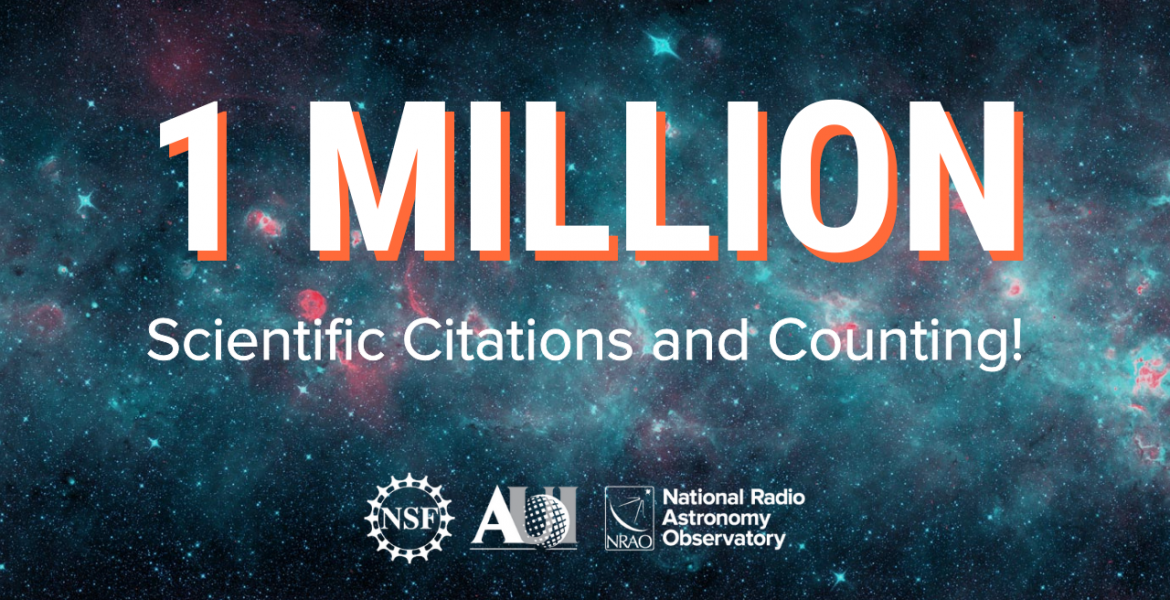AUI will present at the 247th meeting of the American Astronomical Society in Phoenix from January 4-8.
Recent News
ALMA Helps Unmask Monster Black Hole Behind Record-Breaking Cosmic Burst
Astronomers have used the Atacama Large Millimeter/submillimeter Array (ALMA) together with a suite of space- and ground-based telescopes, to study AT 2024wpp, the most luminous fast blue optical transient (LFBOT) ever observed.
Astronomers Make First Radio Detection of Rare Supernova Type, Revealing Secrets of Stellar Death
Astronomers using the U.S. National Science Foundation Very Large Array have captured the first-ever radio signals from a rare class of stellar explosion known as a Type Ibn supernova.
A Million Reasons to Celebrate: NSF NRAO Hits One Million Citations

Credit: NRAO/AUI/NSF
The U.S. National Science Foundation National Radio Astronomy Observatory (NSF NRAO) is celebrating a historic achievement: research using our telescopes has now been cited over one million times in scientific literature!
This remarkable milestone highlights the tremendous impact of our world-class facilities—including the Very Large Array (VLA), Very Long Baseline Array (VLBA),the Green Bank Telescope (GBT), and the Atacama Large Millimeter/submillimeter Array (ALMA). Together, these instruments have fueled groundbreaking discoveries and inspired generations of astronomers worldwide.
Highlights of this achievement:
- The VLA stands out as the most-cited NRAO instrument, with more than 561,000 citations.
- Of the Top 5 most-cited papers connected to NRAO, two are based on our instruments, two were authored by NRAO staff without instrument data, and one showcases key NRAO technology supporting a major space mission.
- The single most-cited NRAO instrument paper is the legendary NRAO VLA Sky Survey (Condon et al. 1998), with over 5,200 citations.
These numbers reflect not only decades of pioneering research, but also the dedication of engineers, staff, and scientists who keep these facilities at the forefront of exploration. From the earliest days of the NSF NRAO to today, every discovery has built toward this extraordinary accomplishment.
As we celebrate, we’re also looking ahead. The new generation of radio science—through projects like the Next Generation Very Large Array (ngVLA), the ALMA Wideband Sensitivity Upgrade, and advances in Next Generation Radar—will open fresh windows onto the Universe.
With more than a million citations behind us and countless discoveries ahead, NRAO remains committed to advancing humanity’s understanding of the cosmos.
Explore the milestone: NRAO Publications Statistics
This news article was originally published on the NRAO website on September 8, 2025.
Recent News
AUI to Attend AAS 247 Conference
AUI will present at the 247th meeting of the American Astronomical Society in Phoenix from January 4-8.
ALMA Helps Unmask Monster Black Hole Behind Record-Breaking Cosmic Burst
Astronomers have used the Atacama Large Millimeter/submillimeter Array (ALMA) together with a suite of space- and ground-based telescopes, to study AT 2024wpp, the most luminous fast blue optical transient (LFBOT) ever observed.
Astronomers Make First Radio Detection of Rare Supernova Type, Revealing Secrets of Stellar Death
Astronomers using the U.S. National Science Foundation Very Large Array have captured the first-ever radio signals from a rare class of stellar explosion known as a Type Ibn supernova.
